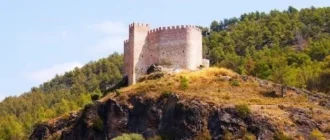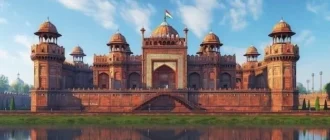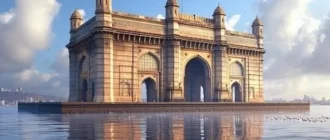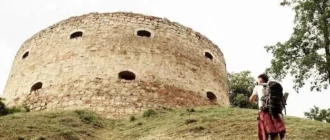Nestled amidst the rugged beauty of the Western Ghats, the Khandala Ghat stands as a testament to natures grandeur and human ingenuity. This historic mountain pass, a vital link between the Deccan Plateau and the Konkan coast, has played a pivotal role in shaping the regions history, trade, and culture.
Geographical Significance
The Khandala Ghat, often referred to as the Bhor Ghat, carves its way through the formidable Sahyadri range, connecting the towns of Khopoli and Khandala in Maharashtra, India. This pass, formed by the erosive forces of the Ulhas River over millennia, presents a breathtaking panorama of deep valleys, cascading waterfalls, and verdant slopes. The Western Ghats, a UNESCO World Heritage site, are known for their rich biodiversity, and the Khandala Ghat offers a glimpse into this natural treasure trove.
Historical Significance
The Khandala Ghats history is steeped in tales of empires and conquests. It served as a crucial trade route for centuries, facilitating the movement of goods, armies, and ideas between the Deccan hinterland and the Arabian Sea ports. The Maratha Empire, under rulers like Chhatrapati Shivaji Maharaj, recognized the strategic importance of the ghat and constructed formidable forts like Lohagad and Visapur to safeguard the passage. The British, during their reign, further developed the pass, expanding the road infrastructure and later constructing a railway line, solidifying its importance in colonial trade and administration.

Engineering Marvel: The Construction of the Bhor Ghat Railway
The construction of the Bhor Ghat railway line in the mid-19th century stands as a testament to British engineering prowess. This challenging project٫ completed in 1863٫ involved overcoming daunting terrain٫ with engineers employing innovative techniques to carve tunnels through mountains and build bridges across deep ravines. The railway line٫ a marvel of its time٫ significantly reduced travel time and spurred economic activity in the region.
Khandala Ghat Today: A Tourists Paradise
Today, the Khandala Ghat is a popular destination for travelers seeking respite from the bustling cities of Mumbai and Pune. The winding road, offering breathtaking views at every turn, is a favorite among road trippers. Several viewpoints along the ghat provide stunning panoramas of the surrounding hills and valleys. The region is also a paradise for hikers and trekkers, with numerous trails leading to ancient forts, hidden waterfalls, and scenic plateaus.
Points of Interest
- Lohagad Fort: A formidable hilltop fort offering panoramic views and a glimpse into Maratha history.
- Visapur Fort: Another imposing fort, often explored in conjunction with Lohagad, known for its intricate architecture.
- Tigers Leap: A cliff-top viewpoint named for its resemblance to a leaping tiger, offering stunning valley views.
- Bhushi Dam: A popular spot for picnics and photography, especially during the monsoon when water cascades down its steps.
- Kune Falls: A majestic three-tiered waterfall cascading down lush green slopes.

Preservation and Challenges
While the Khandala Ghat remains a popular tourist attraction, it faces challenges related to environmental sustainability and the preservation of its historical and natural heritage. Increased tourism can strain local resources, and unplanned development poses a threat to the fragile ecosystem. Efforts are underway to promote responsible tourism, conserve biodiversity, and preserve the historical significance of the ghat for generations to come.
The Khandala Ghat stands as a symbol of resilience, a testament to human ambition in the face of natural challenges. It is a place where history, engineering, and natural beauty converge, offering a unique and unforgettable experience to all who visit.

The Khandala Ghat: A Tapestry of Ecology, History, and Human Endeavor
The Khandala Ghat, more accurately identified as the Bhor Ghat, transcends its geographical categorization as a mere mountain pass. It represents a complex interplay of ecological diversity, historical significance, and human ambition. This intricate tapestry, woven over millennia, warrants a deeper exploration beyond its superficial allure as a scenic tourist destination.
Ecological Significance: A Microcosm of Biodiversity
Beyond its scenic vistas, the Khandala Ghat harbors a wealth of ecological significance. As part of the Western Ghats, a globally recognized biodiversity hotspot, the region boasts a remarkable range of flora and fauna. Dense forests of deciduous and evergreen trees cloak the slopes, providing habitat for a myriad of species, including several endemic and endangered ones. The varied terrain, ranging from steep cliffs to gentle valleys, supports diverse microclimates, further contributing to the rich tapestry of life.
A Historical Crossroads: From Ancient Trade to Colonial Expansion
The Khandala Ghats historical importance is deeply intertwined with its strategic location. For centuries, it served as a vital artery connecting the Deccan Plateau to the Konkan coast, shaping the course of trade, politics, and cultural exchange. Ancient trade routes traversing the pass facilitated the movement of goods, ideas, and people, leaving an indelible mark on the regions cultural landscape. The rise and fall of empires, from the Mauryas to the Mughals, saw the ghat witness numerous power struggles, with control over this crucial passage often dictating regional dominance. The advent of British colonialism further amplified the ghats importance, with the construction of roads and railways transforming it into a key conduit for colonial administration and trade.
Challenges of Modernity: Balancing Development and Preservation
Today, the Khandala Ghat faces the formidable challenge of balancing its historical and ecological significance with the demands of a rapidly developing nation. The allure of this scenic region has led to a surge in tourism, putting pressure on its fragile ecosystem and infrastructure. Unplanned development, driven by economic interests, threatens to encroach upon the natural beauty and cultural heritage of the region. Sustainable tourism practices, coupled with stringent conservation efforts, are crucial to mitigate the impact of human activity and preserve the ghats unique character for future generations.
Looking Ahead: A Shared Responsibility
The Khandala Ghat stands at a crossroads, its future intricately linked to the choices we make today. Recognizing its multifaceted significance ౼ ecological, historical, and cultural ‒ is paramount in ensuring its sustainable future. This requires a concerted effort from policymakers, local communities, and tourists alike. By prioritizing conservation, responsible tourism, and sustainable development practices, we can ensure that the Khandala Ghat continues to inspire and captivate visitors for generations to come.

The Khandala Ghat: A Deep Dive into its Geological and Cultural Significance
Moving beyond its immediate visual splendor, the Khandala Ghat reveals a fascinating narrative etched in its very bedrock and interwoven with the cultural fabric of the region. This deeper understanding necessitates an exploration of its geological origins and the intricate relationship between the landscape and the people who have inhabited it for centuries.
Geological Legacy: A Testament to Earths Dynamic Forces
The Khandala Ghats dramatic topography is a direct consequence of its volcanic origin. As part of the Deccan Traps, one of the largest volcanic features on Earth, the region bears witness to a period of intense volcanic activity millions of years ago. Successive lava flows, solidifying and eroding over eons, sculpted the characteristic stepped plateaus, sheer cliffs, and deep valleys that define the landscape. This unique geology not only contributes to the regions scenic beauty but also influences its soil composition and biodiversity.
The presence of basalt, a hard, dark-colored volcanic rock, is a defining feature of the ghats geology. This rock, formed from cooled lava, weathers slowly, giving rise to the steep slopes and rugged terrain. The basalts mineral composition also contributes to the fertility of the soil, supporting a diverse range of plant life, despite the challenging topography. Furthermore, the ghats geological history has endowed it with a network of natural springs and waterfalls, adding to its ecological and aesthetic value.
Cultural Landscape: A Synthesis of Nature and Human Ingenuity
The Khandala Ghats influence extends beyond its physical characteristics, profoundly shaping the cultural practices and beliefs of the communities inhabiting its slopes and valleys. The regions challenging terrain fostered a spirit of resilience and resourcefulness among its inhabitants. Steep slopes, unsuitable for large-scale agriculture, led to the development of ingenious terraced farming techniques, allowing communities to cultivate crops on otherwise unusable land.
The ghats strategic location as a passageway fostered trade and cultural exchange, but also necessitated defensive strategies. Hilltop forts, strategically positioned along the ghat, stand as testaments to the regions turbulent past, reflecting the ingenuity of its rulers in utilizing the natural landscape to their advantage. These fortifications, often carved into the very rock face of the cliffs, blend seamlessly with their surroundings, demonstrating a deep understanding of the terrain and its defensive potential.
A Call for Sustainable Coexistence: Preserving a Legacy
As the Khandala Ghat navigates the complexities of the 21st century, a critical need arises for a balanced approach that respects its rich geological and cultural tapestry. Uncontrolled development, driven by economic interests, poses a significant threat, potentially disrupting the delicate ecological balance and erasing the historical narratives embedded in the landscape.
Moving forward, responsible tourism practices, coupled with informed conservation efforts, hold the key to ensuring the ghats long-term well-being. Educating visitors about the regions unique geological and cultural significance can foster a deeper appreciation for its fragility, encouraging sustainable practices that minimize human impact. By embracing a holistic approach that acknowledges the interconnectedness of the environment, history, and human activity, we can strive to preserve the Khandala Ghats legacy for generations to come.










